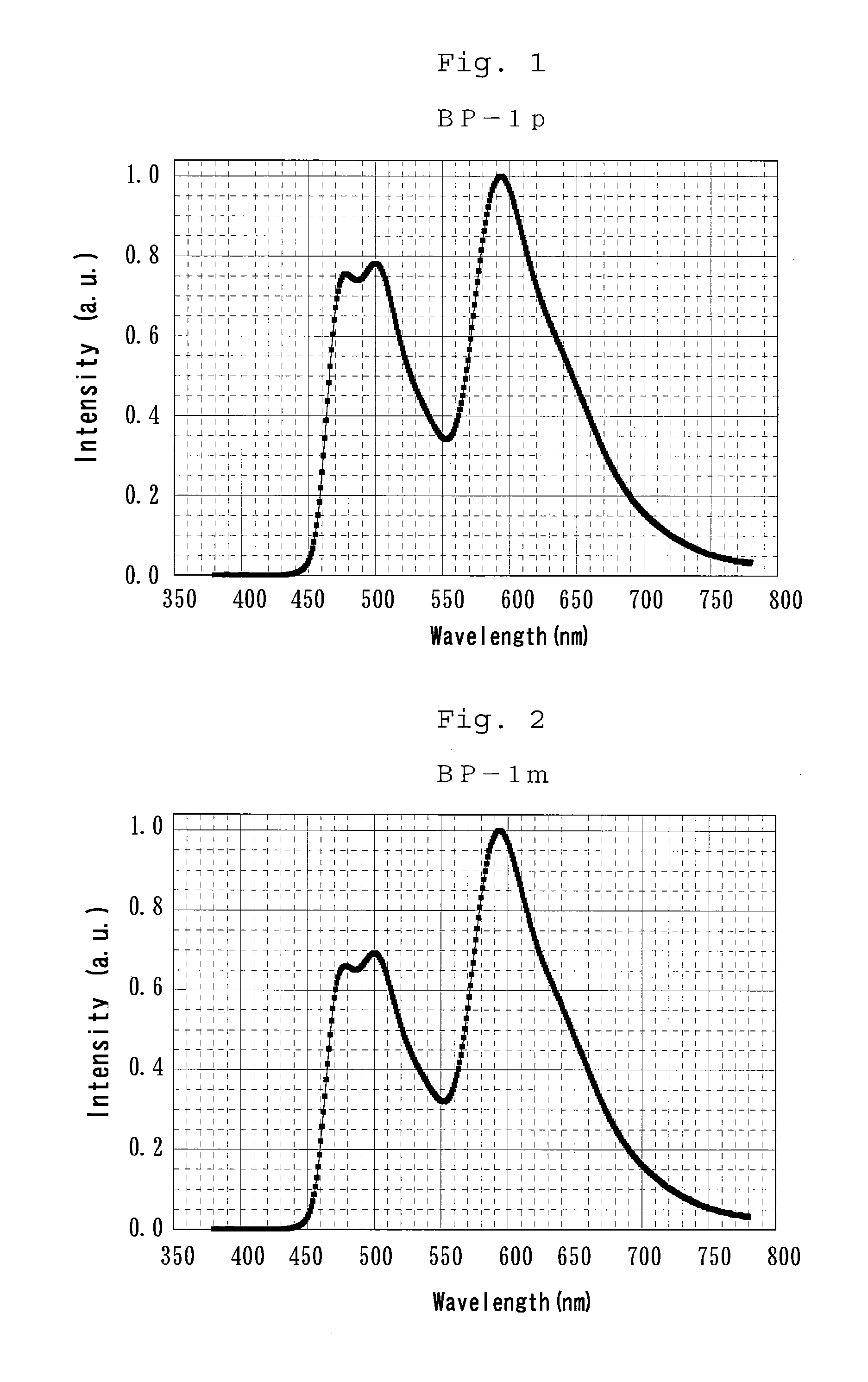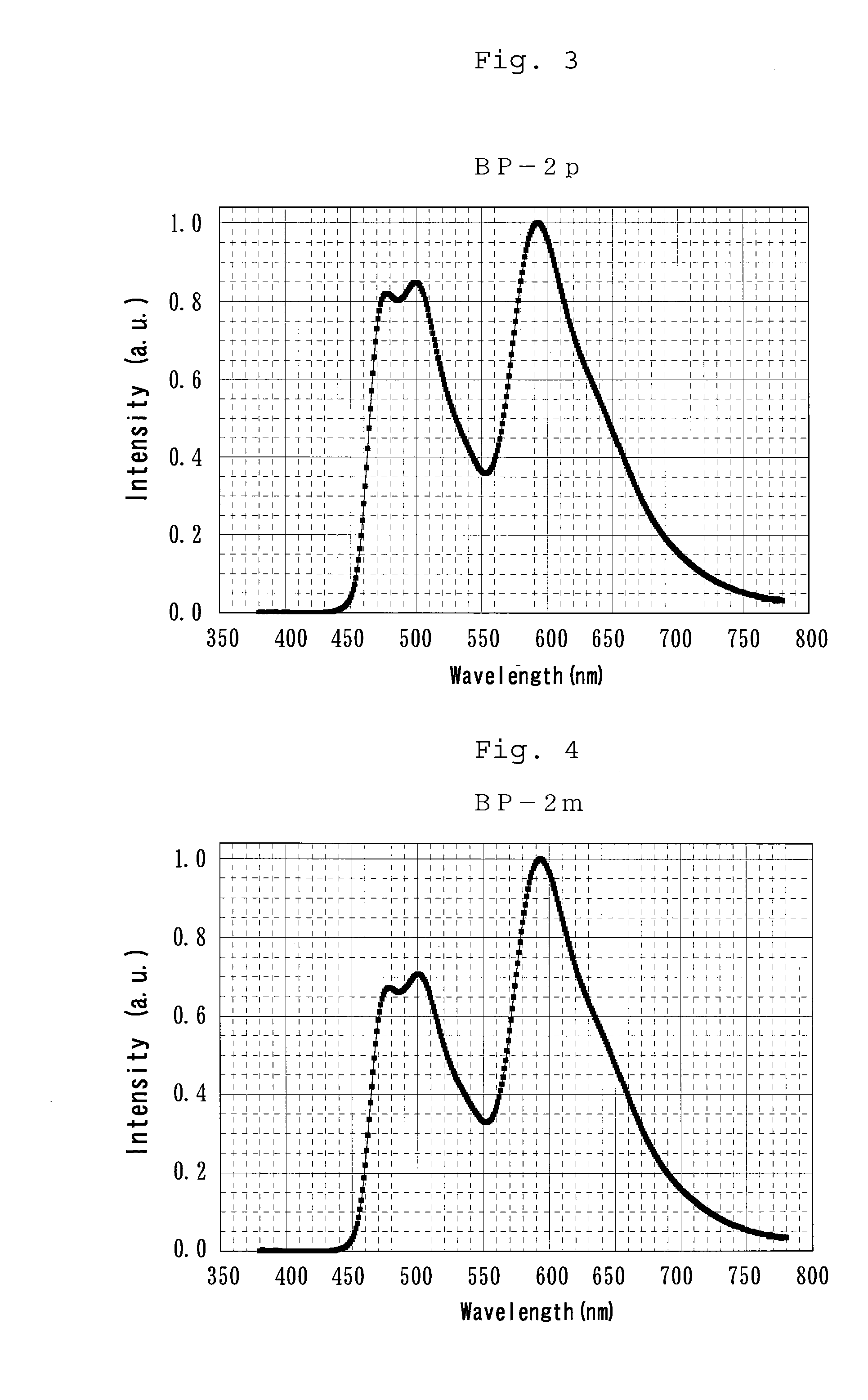Bipiridine derivative and organic electroluminescence element containing the same
a technology of organic electroluminescence and bipiridine, which is applied in the direction of organic semiconductor devices, organic chemistry, thermoelectric devices, etc., can solve the problems of low ionization potential, low efficiency, and inability to obtain blue luminescence having a shorter wavelength than that of green luminescence, and achieve excellent electron transport performance.
- Summary
- Abstract
- Description
- Claims
- Application Information
AI Technical Summary
Benefits of technology
Problems solved by technology
Method used
Image
Examples
example 1
Synthesis of BP-1 Series
[0181]BP-1p and BP-1m were respectively synthesized by a synthesis scheme shown below.
First Process: Synthesis of 5,5′-bis-(3,5-dichlorophenyl)-[2,2′]bipyridinyl)
[0182]9.4 g (29.95 mmol) of 5,5′-dibromo-2,2′-bipyridine synthesized by a known method (see J. Org. Chem., 67, p. 443 (2002)), 20 g (29.95 mmol) of 3,5-dichlorophenylboric acid, 376 ml of toluene, 188 ml of ethanol, 66 ml of 2M sodium carbonate aqueous solution, and 2.1 g (2.995 mmol) of Pd(PPh3)2Cl2 were prepared and reacted in a nitrogen atmosphere for 2 hours.
[0183]The precipitated crystal was filtered and washed with water and methanol. The filtrate was separated and a toluene layer was fractioned. The toluene layer was washed with water twice. After washing, a crude material obtained by collecting toluene was mixed with the filtered precipitate crystal. This crude material was subjected to a silica gel process, and the resulting crude material was recrystallized from dimethylacetamide and purifi...
example 2
Synthesis of BP-3 Series
[0193]BP-3p and BP-3m were respectively synthesized by a synthesis scheme as shown below.
First Process: Synthesis of 5,5′-bis-(3,5-dichlorophenyl)-3,3′-dimethyl-[2,2′]bipyridinyl
[0194]10.2 g (29.92 mmol) of 5,5′-dibromo-3,3′-dimethyl-[2,2′]pyridinyl synthesized by a known method (see Journal of Industrial and Engineering Chemistry, 8, p. 103 (2002)), 24.8 g (104.7 mmol) of 3,5-dichlorophenylboric acid, 408 ml of toluene, 204 ml of ethanol, 66 ml of 2M sodium carbonate aqueous solution, and 2.1 g (2.995 mmol) of Pd(PPh3)2Cl2 were placed and reacted in a nitrogen atmosphere for 11.5 hours.
[0195]The precipitated crystal was filtered, and washed with water and methanol. The filtrate was separated and a toluene layer was fractioned. The toluene layer was washed with water twice. After washing, a crude material obtained by collecting toluene was mixed with the filtered precipitate crystal. This crude material was subjected to a silica gel process, and the resulting...
example 3
Synthesis of BP-2 Series
[0207]BP-2p and BP-2m were each synthesized by a synthesis scheme as shown below.
First Process: Synthesis of 5-bromo-2-(3,5-dichlorophenyl)-pyridine
[0208]30.0 g (126.6 mmol) of 2,5-dibromopyridine, 24.6 g (129.1 mmol) of 3,5-dichlorophenylboric acid, 300 ml of toluene, 150 ml of ethanol, 130 ml of 2M sodium carbonate aqueous solution, and 7.3 g (6.33 mmol) of Pd(PPh3)4 were prepared and reacted in a nitrogen atmosphere for 17 hours.
[0209]Chloroform and water were poured into a reactor vessel and a chloroform layer was fractioned. The chloroform layer was washed with water twice. Its crude material obtained by collecting chloroform was purified with a silica gel column using a developing solvent of chloroform / n-hexane mixture solvent.
[0210]Structure identification was performed by way of MS and 1H-NMR, and it was confirmed that it was a target. Its yield was 27.6 g (71.9% yields).
Second Process: Synthesis of 6,6′-bis-(3,5-dichlorophenyl)-[3,3′]bipyridinyl
[0211...
PUM
| Property | Measurement | Unit |
|---|---|---|
| thickness | aaaaa | aaaaa |
| thickness | aaaaa | aaaaa |
| thickness | aaaaa | aaaaa |
Abstract
Description
Claims
Application Information
 Login to View More
Login to View More - R&D
- Intellectual Property
- Life Sciences
- Materials
- Tech Scout
- Unparalleled Data Quality
- Higher Quality Content
- 60% Fewer Hallucinations
Browse by: Latest US Patents, China's latest patents, Technical Efficacy Thesaurus, Application Domain, Technology Topic, Popular Technical Reports.
© 2025 PatSnap. All rights reserved.Legal|Privacy policy|Modern Slavery Act Transparency Statement|Sitemap|About US| Contact US: help@patsnap.com



